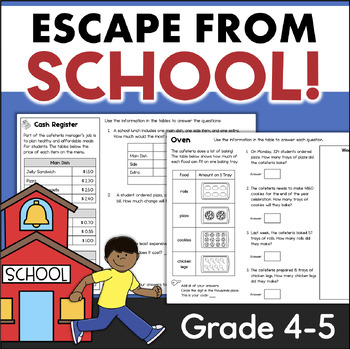Escape Room End of Year ESCAPE THE SCHOOL 4th 5th Grade Math Review Enrichment
- Zip
Description
This Escape the School end of year escape room activity is a super fun and engaging way for students to review and practice a variety of math skills! It is a low-prep activity with an exciting theme designed for 4th to 5th grade.
Students begin by reading an entertaining storyline where they find themselves locked inside the school cafeteria on the last day of school. Unfortunately, everyone else has gone home and the only way to get out is by solving math puzzles.
There are 5 tasks to complete in order to escape the school. Completing a task correctly will reveal part of a secret code. If the code is correct, they advance to the next task. If not, try again!
Once all 5 pieces of the code are collected, students will have the key to get out of the school.
The math tasks in this escape room activity involve:
- adding and subtracting decimals to the hundredths place
- comparing decimal numbers to the hundredths
- adding fractions with like denominators OR multiplying fractions by a whole number (allows use with 4th or 5th grade)
- converting units of measurement
- multiplying whole numbers by a decimal to the hundredths place
- rounding decimals to a whole number
- multiplying and dividing multi-digit numbers
Everything is included to set up your escape room:
- Location cards
- Task sheets for each room
- Recording sheets
- Answer keys
- Teacher directions
- Student directions
This escape room has 2 options for the secret codes:
- Using a device, students enter their answers in Google Forms
- Students check their answers against the teacher's answer key
You can choose whichever option works best for your classroom. The Google Forms option does not require students to sign in or use any personal information. You do not need a Google account. They will simply enter their answers in the form. If it is correct, the form gives them the next clue.
This activity is very easy to implement. There aren't a bunch of pieces to put together and organize. It allows you to review a lot of math skills in one fun activity!
Other escape room activities you might like:
- Escape from the North Pole (Christmas Theme)
- The Great Turkey Escape (Thanksgiving Theme)
- Haunted House Escape
✅ Don't forget to follow me to be notified about my weekly deals and when new products are added!





